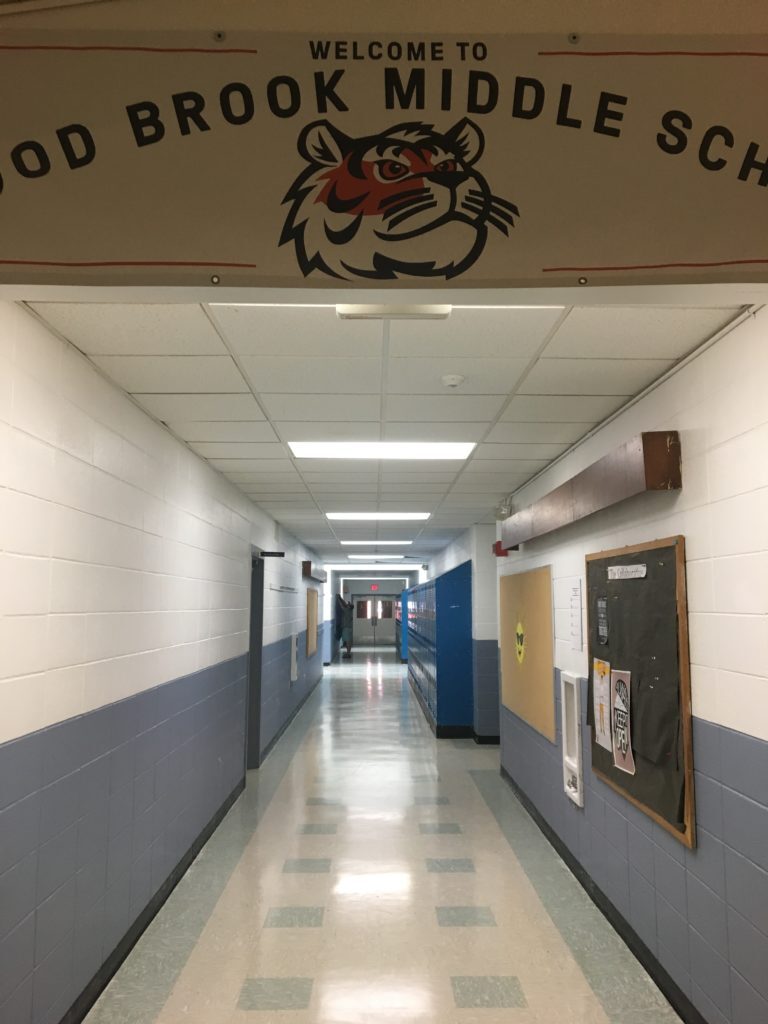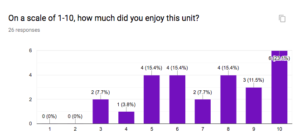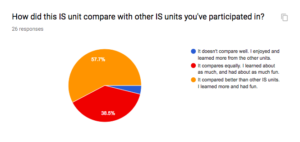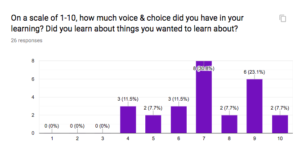At Flood Brook School, middle level teachers believe in an integrated approach to curriculum delivery. Four years into implementing an integrated (science & social studies), multiage (grades 6-8) approach towards units of study, Charlie Herzog responded to student concerns with a focused inquiry cycle asking this important question: How might student attitudes towards integrated units of study shift with increased personalization and when projects are moved to the front of the learning experience? The following chronicle’s Charlie’s year-long experimentation with adjusting his team’s approach to increase student engagement:
“For me, personalization is about giving students as much agency in their learning as possible.”
–Susan Hennessey & Bill Rich

Flood Brook School, in Londonderry, Vermont is a K-8 school; we currently have 82 students in our grades 6-8 middle school. I teach sixth-grade language arts in the morning, and integrated science/social studies during the afternoons.Students rotate through three integrated units of study throughout the year. Integrated studies are scheduled four afternoons per week. Each class is 90-minutes long.
Six classroom teachers and a Library/Media Specialist comprise the middle school teaching team. Classroom teachers have divided into partnerships, each responsible for writing one, integrated, project-based unit of study. Each unit runs from 6-8 weeks. Students cycle among the three units over the course of the year.
This is our first year employing this “divide & conquer” approach. During the prior three years, the entire team collaboratively wrote nine, integrated units.
The typical unit plan structure looked like the following.
- Students rotating among teachers for 3-4 weeks. Each teacher providing a particular science or social studies content focus along the way.
- Content delivery varied from the “Sage On the State” approach to more student inquiry driven.
- An impressive but possibly problematic amount of Cornell note-taking.
- Student projects as the culminating experience of every unit. Typically, the following have always been a feature of the logistics involved in planning culminating projects.
- Groups of three or larger must be multiage. Students form their own groups and partnerships.
- Partnerships may or may not be multiage.
- Students have been given limited choice regarding what form of a project to design.
- Students have been given limited choice regarding the content focus for their projects.
- A sometimes well-intentioned, but an excessive amount of graphic organizers/checklists for students to complete during and in the process of designing and constructing projects.
- A culminating, public exhibition of learning.
What we noticed: All the prior units had the project at the back of the learning experience.
Restructuring to increase personalization
After growing greatly discouraged about attitudes towards and the effectiveness of our integrated approach, I decided to take a risk, and do something Tarrant Institute coach and friend Mrs. Rachel Mark had been gently suggesting to my middle school team for some time, put the project at the front. The project should be the “main course”, not the “dessert”. I further elaborate on my epiphany here.
My teammate Ms. Joey Blaine and I wrote an integrated unit titled Why should we care about human rights? We wrote it with the intention of increased personalization and placing the project at the front of the learning experience.
Our 2nd Integrated Studies Exhibition #floodbrook #vted pic.twitter.com/lk9fGs0LmI
— Charles Herzog (@PJ_Vermont) March 8, 2019
What compelled this intention was the sometimes alarming dissatisfaction students were expressing about integrated studies. We were driven by this Inquiry Question:
How might student attitudes towards integrated units of study shift with increased personalization and when projects are moved to the front of the learning experience?
Check out this video to see the unit results and how we answered this question:
Learning from and with students – teacher inquiry

All middle school students were involved in my research. They were informed of my research at the start of each unit cycle and shared their thinking via Google surveys and focus groups. Debriefs were held at the end of each unit cycle, and students, once again, shared their thinking via surveys and focus groups.
At the end of each unit cycle, I compared, reflected upon and analyzed pre & post unit student data in the following forms: blind numerical, blind written feedback and focus groups I facilitated.




Analysis and Interpretation
The data suggests students’ attitudes towards integrated studies shifted in a positive direction as a result of increased personalization and intentionally putting the project at the front of the learning experience.
Students’ blind written feedback also suggests a positive shift in attitudes. The tone of pre-unit feedback skewed heavily negative, with only a smattering of neutral or positive remarks. Post-unit feedback was far less brutal in tone and divided equally between critical and neutral/positive remarks.
Thoughts and reflections from my reflective blog posts throughout the projects echo many of the observations presented. On the whole, student attitudes appeared more positive. Students’ moaning and groaning about having integrated studies decreased noticeably after the first few class periods of our unit.
Day 3 Monument build: pillar painted, flames, placards and sconces finished. #floodbrook #vted pic.twitter.com/hFUQX7JgaM
— Charles Herzog (@PJ_Vermont) November 15, 2018
Furthermore, in each unit cycle, students took great pride in the monuments they designed and constructed, and they felt good about publicly sharing their products created during small group work.
Insights & Resources
Moving forward, my partner and I endeavor to write integrated units of study with the intention of maximizing opportunities for increased personalization and placing the project at the front of the learning experience, as the data suggests doing so increases engagement and develops a positive mindset of the content under study.
While there was less teacher talking than in past units, there was still too much. However, consider that a significant degree of teacher-led discussion was about the Holocaust. We felt this required teacher-led discussion due to the sensitive nature of the topic. Regarding the science content, that too was skewed towards teacher-led discussions. In the future, we endeavor for students to engage in science content in a more self-directed manner, whenever possible.
Launch events are more important than we realized. On the first day of each unit, we took students on a field trip of southern Vermont monuments. We observed, to differing degrees, this increased student “buy-in” for the unit. Thank you to the Tarrant Institute’s Susan Hennessey for the idea. My partner and I will continue planning engaging unit launch events.
PBL Launch event. If you’re gonna build a monument you might as well visit some and discuss design, what they’re communicating, etc. Big thanks to @VTEducare & @hennesss!! #floodbrook #fbs #vted pic.twitter.com/zx9KPjlz1A
— Charles Herzog (@PJ_Vermont) October 8, 2018
For those interested in developing authentic project-based units of study here are some resources:
- PBL or PB&J: How can you tell the difference between projects and project-based learning?
- 5 lessons learned from an integrated middle school PBL unit: Reflections from the Burke Town School
- Kick off project-based learning with a community event: Hope launches in the Northeast Kingdom.
- Buck Institute For Education: PBLWORKS
- The PBL Playbook: A Step-by-Step Guide to Actually Doing Project-Based Learning
- Project Based Teaching: How to Create Rigorous and Engaging Learning Experiences

